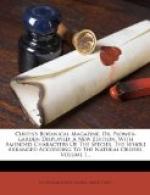lobes more or less obtuse, which give it an arrow-shaped form,
bifid at the apex, hollow, and containing the antherae, the edges
of the duplicature crisped and forming a kind of frill from the
top to the bottom.
STAMINA five Filaments arising from the base of the
nectary, short and
distinct; Antherae
long and linear, attached to and cohering by
their tips to
the apex of the nectary.
STYLE filiform, white, length of the nectary.
STIGMA three quarters of an inch long, attached to,
and hitched on as it
were to the tip
of the nectary, roundish, white, awl-shaped, very
viscid, becoming
as the flower decays of a deep purple brown
colour, and usually
splitting into three pieces, continuing
attached to the
nectary till the nectary decays.
Mr. FAIRBAIRN, to whose abilities and industry the Companies Garden at Chelsea is indebted for its present flourishing state, being desirous of obtaining ripe seeds, I had no opportunity of examining the germen.
Such were the appearances which presented themselves to us in the plant which flowered at the Chelsea Garden; that they are liable to considerable variation is apparent from the figure of Mr. MILLAR, which appears to have been drawn from a very luxuriant specimen, as two spathae grow from one flowering stem, the stigma is also remarkably convoluted, many other appearances are likewise represented, which our plant did not exhibit: in the figure given in the Hortus Kewensis, the stigma appears to have separated from the nectary on the first opening of the flower, and to be split into three parts, neither of which circumstances took place in our plant till they were both in a decaying state.
[121]
NARCISSUS INCOMPARABILIS. PEERLESS DAFFODIL.
Class and Order.
HEXANDRIA MONOGYNIA.
Generic Character.
Petala 6 aequalia: Nectario infundibuliformi,
1-phyllo: Stamina
intra nectarium.
Specific Character and Synonyms.
NARCISSUS incomparabilis spatha uniflora, nectario
campanulato plicato
crispo petalis
dimidio breviore, foliis planis.
NARCISSUS latifolius omnium maximus amplo calice flavo
sive Nompareille.
The great Nonesuch
Daffodil, or incomparable Daffodil. Park. Par.
p. 68.
[Illustration: No 121]
This species of Narcissus, though well described and
figured by the old
Botanists, especially PARKINSON; has been overlooked
by
LINNAEUS.
It is undoubtedly the incomparable Daffodil of PARKINSON, figured in his Garden of Pleasant Flowers; and the incomparabilis of MILLER’s Dict. ed. 6. 4to. the latter informs us, that he received roots of it from Spain and Portugal, which fixes its place of growth.




